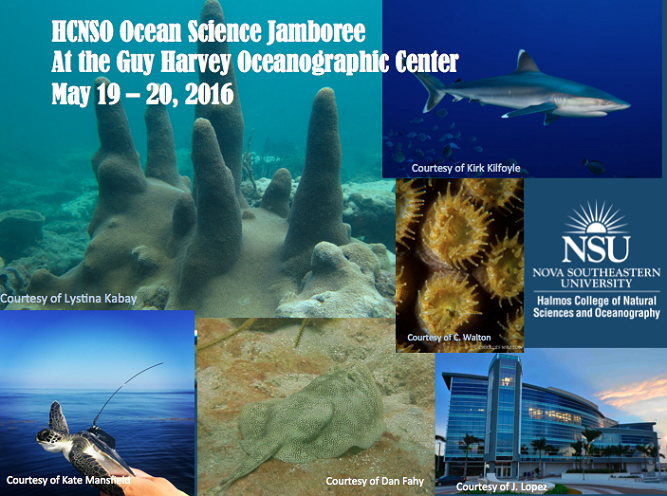Geographic Variability in Habitat Selection and Movements of a Marine Top Predator
Location
Guy Harvey Oceanographic Center Facility
Start
5-19-2016 2:00 PM
End
5-19-2016 2:15 PM
Abstract
To maximize fitness within heterogeneous landscapes, animals are predicted to attempt to maximize time in profitable environments. Animals may achieve this is by adjusting their movements in response to environmental stimuli; for example by adopting an area-restricted search (ARS) strategy in high resource patches. This allows inferences about habitat selection and significance of environmental features to be drawn from movement behavior. For widely distributed species, ecological relationships to specific environmental variables are unlikely to be consistent across large geographic areas, as individuals in distant regions adapt to conditions specific to the ecosystems they inhabit. To test this, we used satellite telemetry to study the movement behavior of a highly mobile marine predator, the shortfin mako shark (Isurus oxyrinchus), tagged from locations along the northeast coast of the U.S. and the Yucatan Peninsula. Our goal was to elucidate how habitat selection and movement ecology varied between two adjacent but ecologically distinct regions of the northwest Atlantic; the Caribbean/Gulf of Mexico marginal sea region (CGM), and the open ocean region of the western north Atlantic (OWA). We used state-space models to derive daily location and behavioral state estimates for all sharks, and analyzed the relationship between ARS behavior and environmental conditions within each region. We tracked 39 mako sharks during 2013 – 2015. Bouts of consecutive days in ARS lasted significantly longer in CGM (mean = 45) than in OWA (mean = 20). In the temporally dynamic OWA, makos exhibited clear seasonality in ARS behavior, with the proportion of days each month in ARS behavior peaking in September. In CGM however, where environmental conditions are less seasonally distinct, no ARS seasonality was evident. In both regions, probability of ARS was positively associated with shallow water and primary productivity (PP), although the effect of PP was greater in OWA. Bathymetric slope was associated with ARS in the OWA, but there was no effect in the CGM. While makos in the CGM where likely to engage in ARS in areas of high current velocity, there was a negative association with velocity and current edges in the OWA. These differences in habitat selection likely reflect responses to variability in the forces that determine the distribution and availability of prey in each respective region. Our study highlights the importance of studying widely distributed organisms across broad geographic gradients, as studies within a limited geographic region may lead to inferences that are not widely generalizable, with potentially negative conservation implications.
Geographic Variability in Habitat Selection and Movements of a Marine Top Predator
Guy Harvey Oceanographic Center Facility
To maximize fitness within heterogeneous landscapes, animals are predicted to attempt to maximize time in profitable environments. Animals may achieve this is by adjusting their movements in response to environmental stimuli; for example by adopting an area-restricted search (ARS) strategy in high resource patches. This allows inferences about habitat selection and significance of environmental features to be drawn from movement behavior. For widely distributed species, ecological relationships to specific environmental variables are unlikely to be consistent across large geographic areas, as individuals in distant regions adapt to conditions specific to the ecosystems they inhabit. To test this, we used satellite telemetry to study the movement behavior of a highly mobile marine predator, the shortfin mako shark (Isurus oxyrinchus), tagged from locations along the northeast coast of the U.S. and the Yucatan Peninsula. Our goal was to elucidate how habitat selection and movement ecology varied between two adjacent but ecologically distinct regions of the northwest Atlantic; the Caribbean/Gulf of Mexico marginal sea region (CGM), and the open ocean region of the western north Atlantic (OWA). We used state-space models to derive daily location and behavioral state estimates for all sharks, and analyzed the relationship between ARS behavior and environmental conditions within each region. We tracked 39 mako sharks during 2013 – 2015. Bouts of consecutive days in ARS lasted significantly longer in CGM (mean = 45) than in OWA (mean = 20). In the temporally dynamic OWA, makos exhibited clear seasonality in ARS behavior, with the proportion of days each month in ARS behavior peaking in September. In CGM however, where environmental conditions are less seasonally distinct, no ARS seasonality was evident. In both regions, probability of ARS was positively associated with shallow water and primary productivity (PP), although the effect of PP was greater in OWA. Bathymetric slope was associated with ARS in the OWA, but there was no effect in the CGM. While makos in the CGM where likely to engage in ARS in areas of high current velocity, there was a negative association with velocity and current edges in the OWA. These differences in habitat selection likely reflect responses to variability in the forces that determine the distribution and availability of prey in each respective region. Our study highlights the importance of studying widely distributed organisms across broad geographic gradients, as studies within a limited geographic region may lead to inferences that are not widely generalizable, with potentially negative conservation implications.


